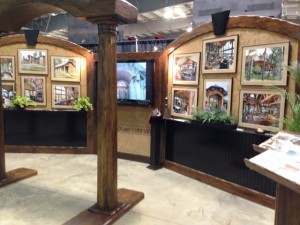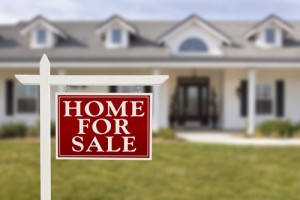A Rising Housing Market Lifts Builders, Home Goods Retailers
BY THE ASSOCIATED PRESS: NEW YORK — May 24, 2016, 1:41 PM ET
A new report from the U.S. that showed Americans are snapping up homes at a pace not seen since the housing bust-fueled recession pushed the trading of shares of all companies affiliated with the sector into overdrive Tuesday.
The Commerce Department reported that new home sales jumped 16.6 percent last month to a seasonally adjusted rate of 619,000, up from a revised total of 531,000 in March. A mix of steady job gains and historically low mortgage rates are bringing more Americans back into a housing market even as rising prices put many properties out of range.
Sales of existing homes, which make up 90 percent of the housing market, rose in April for a second straight month to an annual pace of 5.45 million, a figure consistent with a solid economy.
That’s the highest level since January 2008, when the U.S. was teetering into the worst economic downturn since the Great Depression.
While there has been talk about the possibility of a second housing bubble bursting as it began to do in the U.S. in 2006, at least part of the reason prices are skyrocketing is a lack of supply. So many Americans were financially devastated by the recession, builders focused construction rental units in its aftermath.
With demand clearly burgeoning, that has begun to shift.
The U.S. reported last week that new home construction climbed 6.6 percent to a seasonally adjusted annual rate of 1.17 million units in April.
Ground breakings are running ahead of last year’s pace, largely because of a dramatic increase in the construction of single-family houses, especially in the Midwest and South.
Wall Street has taken note, and investors want a piece of any company that would be swept up in the nation’s housing acceleration.
Shares of homebuilder DR Horton rose 4 percent, while KB Home jumped 5.5 percent. Hovnanian Enterprises Inc. jumped more than 9 percent and Toll Brothers put up big quarterly numbers Tuesday, its shares rising 8 percent.
Home building suppliers Masco Corp. and American WoodMark Corp. rose 2.5 percent and 4 percent, respectively.
Newell Brands, which makes storage products and more for the home, and appliance-maker Whirlpool also gained ground.
Home Depot Inc. and Lowe’s both put up huge numbers for the first quarter recently and shares of both home supply retailers hit all-time highs this month.
Flathead Home and Garden Show

The Flathead Valley Home and Garden Show had more optimism from vendors and visitors than any of the recent years. From builders to landscapers, we all met with some great prospects and found great leads! The annual event is hosted by the Flathead Building Association and takes place at the Kalispell Fairgrounds. The show provides unlimited information for anyone interested in building a new home, remodeling, or landscaping their current home. It’s also a great time to mingle with the other vendors and get their take on the current market conditions.
Click Image to View and Listen to ‘Montana On My Mind’
Being a 5th generation native of Montana and 3 generations of Design/Builders we endorse this song as it places value and touches at the essence of what Montana is all about. Click the image below to enjoy the magnificent photos and lyrics.
Click on the Link Below to View the Anatomy of a Home by Greg Bain and Company
Greg Bain and Company has been welcoming our clients home for 4 decades. Enjoy our 2 minute version of the 7 month odyssey by clicking the link below!
Greg Bain and Company’s Home Anatomy
The Great Senior Sell-Off Could Cause the Next Housing Crisis
by Emily Badger, Staff Writer at The Atlantic Cities

Demographers often describe the baby boom generation as if it were an indigestible mammal – maybe a pig, or a rabbit, or a really big rat – slowly moving through the python that is America’s population. As this generation has aged, the baby boom bulge has remade society in its image, first as a massive class of toddlers, later as rabble-rousers in the 1960s, then as solidly middle-class heads of household and, soon, as the largest class of retirees the country has ever seen.
Along the way, this generation has also left a physical imprint on the American landscape with potential impacts as long-lasting as many of the social changes boomers brought. In the 20 years between 1990 and 2010, these consumers were at their peak family size and peak income. And suddenly, there was massive demand in America from the same kinds of people for the same kinds of housing: big, large-lot single-family homes (often in suburbia). In those two decades, calculates researcher Arthur C. Nelson, 77 percent of demand for new housing construction in America was driven by this trend.
Looked at another way, he adds, in all that time “there was virtually no demand for starter homes.”
In the coming years, baby boomers will be moving on (inching further through the python, if you will). “They will want to sell their homes, and they’re hoping there are people behind them to buy their homes,” says Nelson, director of the Metropolitan Research Center at the University of Utah. He expects that in growing metros like Atlanta and Dallas, those buyers will be waiting. But elsewhere, in shrinking and stagnant cities across the country, the story will be quite different. Nelson calls what’s coming the “great senior sell-off.” It’ll start sometime later this decade (Nelson is defining baby boomers as those people born between 1946 and 1964). And he predicts that it could cause our next real housing crisis.
We can predict the next housing crash, and that’ll be in about 2020.
“Ok, if there’s 1.5 to 2 million homes coming on the market every year at the end of this decade from senior households selling off,” Nelson asks, “who’s behind them to buy? My guess is not enough.”
According to data from the American Housing Survey, from 1989 and 2009, 80 percent of new homes built in that era were detached single-family homes. A third of them were larger than 2,500 square feet. And most startling – “I checked my numbers over and over again,” a bemused Nelson says – 40 percent were built on lots of half an acre to 10 acres in size. Now, he says, 74 percent of new housing demand will come from the people who bought these homes, now empty-nesters, wanting to downsize.
A vast majority of today’s households with children still want such houses, Nelson says. But about a quarter of them want something else, like condos and urban townhouses. That demand “used to be almost zero percent, and if it’s now 25 percent,” Nelson says, “that’s a small share of the market but a huge shift in the market.” And this is half of the reason why many baby boomers may not find buyers for their homes. “Even if the numbers matched,” Nelson says, “the preferences don’t.”
Demographics will further complicate this picture. We’re moving toward a future in America when minorities will become the majority. But given entrenched educational achievement gaps, particularly for the fast-growing Hispanic population, Nelson fears that the U.S. is not doing a good job educating the “new majority” to make the kinds of incomes that will be required to buy the homes we’ve already built.
As the Hispanic population expands, and more baby boomers retire, the gap between the two groups in the housing market – expressed in unsellable houses – will only widen.
“That’s going to hit us,” Nelson says. “Not right now. But my guess is that about the turn of the decade, that number will become a real number. It’s only a few percentage points now, but it’s like a glacier, and if it keeps moving and building and growing, it’s going to be a big number in about 2020.”
Roughly 7 percent of over-65 households move each year, and as people get older, their likelihood of moving from owning to renting gets higher and higher (it’s about 79 percent for households over 85). By 2020, there were will be around 35 million over-65 households in the U.S. That year, Nelson calculates, seniors who would like to become renters will be trying to sell about 200,000 more owner-occupied homes than there will be new households entering the market to buy them. By 2030, that figure could rise to half a million housing units a year.
“Between changing preferences and declining median household income because of poor education – because we’re not willing to spend money on education,” Nelson says, “that means we can predict the next housing crash, and that’ll be in about 2020.”
In that environment, he says, there will be two classes of seniors in America: those “aging in place” voluntarily, and those “aging in place” involuntarily because they can’t sell their homes. Nelson is critical that “aging in place” will really be feasible for many seniors.
“It’s romantic for the first 15 years when you’re turning 65 and retired,” he says. “But aging in place among 90-year-olds? 95-year-olds?” Many of these people, he predicts, won’t realize that they can’t mow the lawn or pay for repairs until they’re really elderly, and the market for the their homes has collapsed even further. “My suspicion,” Nelson says, “is that many hundreds of thousands, maybe millions of those households in the 2020s to 2030 and beyond will simply give up the house and walk away.”
Our most recent housing crisis targeted all age demographics, including large numbers of young families and first-time homebuyers. The coming problem, Nelson predicts, will originate with – and primarily affect – America’s aging grandparents already well into their retirement.
Top image: Andy Dean Photography/Shutterstock
